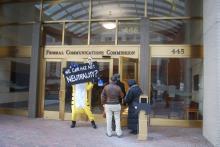
This week’s episode of our Community Broadband Bits podcast is particularly insightful for communities considering how to leverage the broadband expansion funds embedded in the Infrastructure Investment and Jobs Act (IIJA) passed in November 2021.
Although the funds will likely not be allocated to state grant programs until the end of 2022/early 2023, the time is now for state and local leaders interested in building community-owned networks to best position themselves to take advantage of this once-in-a-generation investment.
Christopher is joined by Nancy Werner, General Counsel of the National Association of Telecommunications Officers and Advisors (NATOA), an under-the-radar organization that advises local government officials on telecommunication issues.
During the conversation, the two talk about NATOA and its role in supporting community broadband projects with a particular focus on how the Broadband Equity, Access and Deployment (BEAD) program contained in the infrastructure bill is structured. Christopher and Nancy zero in on exactly how BEAD grant money can be used. Although the bill was written to first focus on mostly rural communities who do not have access to minimum broadband connections of 25/3 Megabits per second, they delve into the nitty gritty of how the funds can be used to prioritize bringing high-speed Internet access to multi-dwelling units even in densely-populated urban centers.
As Christopher notes:
This is important because this is a question of whether we are going to spend the vast majority of this money in areas that are more rural … or if we are going to spend any money in urban areas ... It is incontrovertible that we have neglected the many more millions of people in urban areas. This is a time to make sure that we are not just picking one or the other.
The show ends with an exploration of the promise and shortcomings of taking a simplified approach to setting Right-of-Way and franchise fees, which are areas that are notoriously difficult waters to navigate as new networks are being built.
This show is 30 minutes long and can be played on this page or via iTunes or the tool of your choice using this feed. You can listen to the interview on this page or visit the Community Broadband Bits page.
Transcript coming soon.
We welcome your feedback and suggestions for the show. You can e-mail us or leave a comment below.
Listen to other episodes here or view all episodes in our index.
Also, don’t forget about the Institute for Local Self-Reliance other podcast, the Building Local Power podcast, which you can find here on iTunes or Stitcher to catch more great conversations about local communities, the concentration of corporate power, and how everyday people are taking control.
Thanks to Arne Huseby for the music. The song is Warm Duck Shuffle and is licensed under a Creative Commons Attribution (3.0) license.
Header image of keyboard courtesy of The Blue Diamond Gallery, Attribution-ShareAlike 3.0 Unported (CC BY-SA 3.0)







